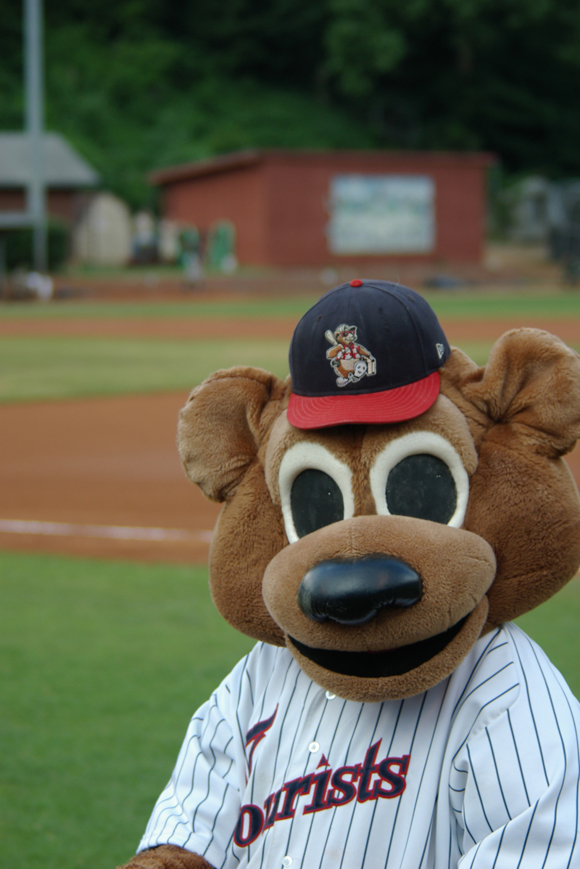McCormick Field, the longtime home of the Asheville Tourists, is both a classic ballpark of the Sally League and an example of a ballpark reconstruction done right. Located on the edge of downtown Asheville, McCormick Field has been the psychic center of baseball in Asheville since opening in 1924.
FAST FACTS
Year Opened: 1924; rebuilt 1992
Capacity: 4,000
Architects: Bowers, Ellis, and Watson
Construction: Leader Construction
Dimensions: 326L, 386LC, 373C, 297R
Website: theashevilletourists.com
Phone: 828/258-0428
League: South Atlantic League
Affiliation: Colorado Rockies
Parking: Street parking adjacent to the ballpark and in a small adjoining parking lot.
Address/Directions: 30 Buchanan Place, Asheville. The ballpark is located on the eastern edge of downtown Asheville. From I-240, take the Charlotte Street South exit, go south one mile on Charlotte, and turn left on McCormick Place (AAMCO Transmission on the corner). McCormick Field is on the left. From I-40, take Exit 50 (Biltmore Avenue), go north on Biltmore Av. past Mission St. Joe’s Hospital, past the Ford dealer, through one traffic light and right at the next street, McCormick Place (gas station on the corner). McCormick Field is on the right.
McCormick Field, the longtime home of the Asheville Tourists, is both a classic ballpark of the Sally League and an example of a ballpark reconstruction done right. Located on the edge of downtown Asheville, McCormick Field has been the psychic center of baseball in Asheville since opening in 1924.
It’s a cozy ballpark: McCormick seats only 4,000 (all between the foul lines), and the right-field wall (shown below) is only 300 feet down the line (the same as the original McCormick Field) and 35 feet high, just two feet shorter than the Green Monster at Fenway Park. It does change the dynamics of a game: during my visit Tourists 1B Simon Ferrer was thrown out at second by Augusta GreenJackets RF Brandon Moss after hitting one off the top of the fence.
UPDATE: The outfield fence has been changed since our initial visit, with the 35-foot-tall fence gone. A new scoreboard in right is 42 feet high by 94 feet wide, and the team estimates that more than 40 homeruns is 2006 stayed in the field compared to the earlier configuration.
The pregame entertainment consisted of kids trying to score autographs (which wasn’t difficult; Tourists players aren’t that much older than some of the kids and seemed tickled to be asked for their signatures) and the onfield antics of Ted E. Tourist, surely the best and hardest-working mascot in the minors. How hard-working? Ted E. worked the crowd from a unicycle before the game (you try riding a unicycle for 30 minutes on a soft field), did pushups during the course of the game (you try doing 30 or 40 pushups in a mascot uniform) and still had the energy to dance with fans and generally entertain the crowd.
There is a certain sense of timelessness at a Tourists game. McCormick Field is set on the side of a hill, with the background mostly trees and an obstructed view of a football field. There are no views of the city, nothing to intrude in the essential timelessness of an Asheville baseball game. The emphasis at Tourists game is on the baseball: there are some between-inning activities, but when watching the crowd I got the sense that a baseball game was a true community activity: folks were continually running into old and new friends. Despite the threat of rain (play would be interrupted more than once), most fans stuck around for the entire game.
The ballpark occupies a pretty small footprint, which makes for some interesting design decisions. There’s nothing beyond the outfield wall, and in back of the grandstand is a multi-story covered concession area with columns that are reminiscent more of a football stadium than a baseball ballpark. (The columns support the roof that covers most of the grandstand.) There are six rows of box seats and 10 rows of seat-back bleachers, with two sections at the ends of the grandstand with no seats at all. (Refreshingly, there are no luxury boxes.) The back of the grandstand leads over to a separate souvenir building and box office next to the main entrance. (The original McCormick Field also features small buildings in the same locations.) The buildings and the grandstand all feature of plenty of brickwork, making the ballpark feel older than its 1992 birthdate.
Upon leaving the ballpark, I was treated to a ballet of fireflies flickering over a sea of clover besides the ballpark. It doesn’t get any better than that.
BEFORE/AFTER THE GAME
Downtown Asheville is within walking distance of the ballpark. A variety of great restaurants and stores can be found there, especially if you’re a beer fan. Our favorite is Ashville Brewing (77 Coxe Avenue; ashevillebrewing.com), where the brewers regularly push the envelope. Show up on a Thursday night and see what sort of concoction is being created with the Randall.
HISTORY
Asheville has been a great baseball town for decades, with the Tourists name lasting throughout.







